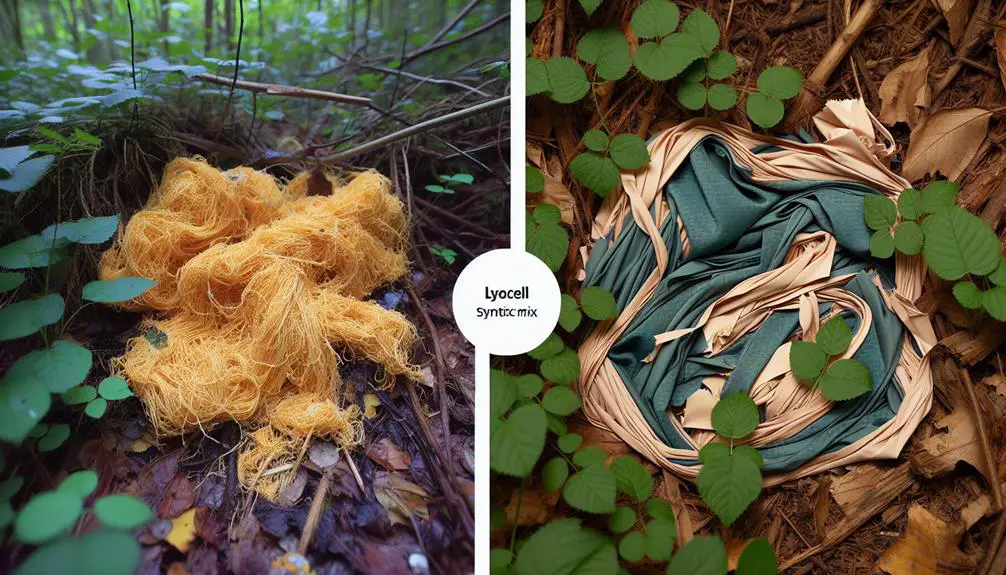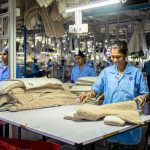Lyocell's not perfect, you know. It's usually pricier than cotton because it's made with high-tech methods and sustainable sources which bump up the cost. Taking care of it can be a headache too. You've got to wash it cold or by hand, and forget about tossing it in the dryer unless you love shrinkage. And while it's marketed as eco-friendly, some companies stretch the truth, which isn't cool. It also doesn't come in as many styles due to its lower demand and high production costs. And yeah, it might not last as long if you're not super careful with it. Looks like there's a bunch more to uncover about this fabric, huh?
Table of Contents
Key Takeaways
- Lyocell is more expensive than many other fabrics due to high production costs and specialized technology.
- Requires careful maintenance such as gentle washing and air drying to avoid damage.
- Environmental claims about Lyocell can be misleading due to greenwashing and lack of transparency in manufacturing.
- Durability issues like pilling and susceptibility to damage from heat can limit the lifespan of Lyocell garments.
- Limited style availability in Lyocell due to lower market demand and higher production expenses.
Higher Cost Than Cotton
One major downside of Lyocell is that it's pricier than cotton. The reason? It all boils down to how it's made. Lyocell's production process isn't just about spinning and weaving; it involves some pretty specialized technology that cranks up the cost. This isn't just your regular fabric-making routine. It's a bit more high-tech and complex, which means more bucks out of your pocket.
Now, where Lyocell comes from also plays a big part in its price tag. The raw materials and how they're sourced can really push up the cost. It's not just grabbing any plant fiber; it requires specific sustainable sources, and making sure everything's eco-friendly adds to the expenses.
Then there's the market demand. Lyocell is still catching on compared to cotton, which everybody knows and loves. This lower demand means it doesn't benefit from the economies of scale that help keep costs down for more widely used materials.
Special Care Requirements
Besides its higher cost, Lyocell also demands some extra TLC when it comes to care. You've really got to be gentle with this fabric. The care requirements aren't just a suggestion—they're a must if you want to keep your clothes in top shape. We're talking cold washing or even hand washing to avoid any damage. And honestly, if you're not careful, you could end up ruining a perfectly good piece of clothing.
Now, when it comes to drying, you'll want to skip the dryer. Air drying is the way to go to prevent shrinkage and maintain the fabric's integrity. And ironing? Keep it minimal. Too much heat can harm the fibers, making them weak and less durable over time.
It's also worth mentioning that some Lyocell items might include non-biodegradable fibers. This mix can complicate things if you're trying to stay on the sustainable side of fashion. Not only does it make recycling a bit of a headache, but it also impacts how eco-friendly your wardrobe really is. So, if you're all about that green life, you'll want to keep an eye on what your Lyocell garments are mixed with.
Susceptible to Greenwashing
Lyocell's reputation for being eco-friendly isn't always what it seems; some companies use greenwashing to attract those of us who care about the environment. It's disappointing when you realize not every claim of sustainability holds up under scrutiny. Here's a rundown of how greenwashing can happen with Lyocell:
- Misleading Claims: Some brands overstate the eco-friendly benefits of Lyocell, suggesting it has no environmental impact at all, which isn't entirely true.
- Lack of Transparency: Companies mightn't disclose the full manufacturing process, hiding aspects that are less sustainable.
- Vague Standards: The textile industry sometimes lacks clear, enforceable standards for what constitutes an eco-friendly product. This makes it easy for brands to claim they're green without meeting significant criteria.
- Insufficient Regulations: Without strict regulations, there's little to stop companies from falsely marketing their products as environmentally friendly.
As someone who's deeply interested in sustainability, I find it crucial to do my homework. It's important to research brands and look for reputable certifications that verify the eco-claims. This way, I can trust that my choices support genuine sustainability efforts in the textile industry, not just marketing hype.
Potential Durability Issues
Despite its strengths, I've noticed that Lyocell can pill or fluff, which really requires careful maintenance to keep it looking good. This isn't a deal-breaker, but it's something to keep in mind if you're considering this fabric for your wardrobe. Durability issues like fluffing or pilling mean that you'll need to be gentle with washing and wearing Lyocell items.
Another thing I've seen is the fabric's color vibrancy fading over time, especially if it's not cared for properly. To prevent this, it's crucial to follow care labels closely, avoiding harsh detergents and minimizing exposure to direct sunlight which can really zap the life out of the colors.
Heat exposure and ironing effects are also points of caution. Lyocell doesn't take kindly to high heat. Excessive ironing or drying can damage the fibers, making them brittle or causing them to break down faster than you'd expect. Always use low heat settings to keep your clothes in top shape.
Limited Style Availability
While we're on the topic of Lyocell, it's also worth noting that you mightn't find as many style options as you'd with more common fabrics. This limited style availability can be a bit of a letdown if you're all about staying on top of trends or if you're hunting for specific designs.
Here's why you might see less variety:
- Production Costs: Producing Lyocell is generally pricier than more widespread materials like cotton. This higher cost can deter designers and brands from experimenting too much with this fabric.
- Market Demand: Since not everyone is clamoring for Lyocell, there's less incentive for companies to diversify their offerings. It's a bit of a chicken and egg situation—less demand leads to fewer styles, which in turn can stifle further interest.
- Mainstream Retailers: Many of the bigger, well-known stores stick to what sells best. And often, that's not Lyocell. They typically go for the more established, less expensive materials.
- Diverse Styles in Niche Markets: You might find more varied styles in smaller, specialty brands that focus on sustainability, but these can be harder to come by.
Complex Manufacturing Process
The manufacturing process of Lyocell involves several complex steps that use chemicals and specialized machinery. It's not just about spinning fibers; it's a full-on chemical process. They start by dissolving wood pulp using chemical solvents like NMMO, which sounds simple, but trust me, it's not. This solvent needs to be handled with care to ensure it doesn't wreak havoc on the environment.
Next, they've got to extrude these fibers through specialized equipment. It's like forcing spaghetti through a tiny hole, except imagine the spaghetti is super delicate and can break if not done right. Each of these intricate steps adds up, making the process complex and costly.
Why does this matter? Well, those higher production costs aren't just numbers on a page. They can make Lyocell pricier compared to other fabrics, which might turn off some buyers. Also, understanding how intricate this whole thing is helps us see why it's tough to claim full sustainability. Sure, the end product is eco-friendly, but getting there? It's a bit of a journey. So, while Lyocell has its perks, this complex manufacturing process is definitely a drawback to keep in mind.
Environmental Impact Concerns
As I look into Lyocell's environmental impact, I can't ignore the resource-heavy production it involves. The use of chemical solvents during manufacturing raises serious sustainability questions.
Additionally, there's uncertainty about how well Lyocell blends decompose, which complicates their end-of-life disposal.
Resource Intensive Production
Lyocell's production demands a lot of energy and water, raising some serious environmental concerns. While it's often touted as an eco-friendly fabric, we've gotta dig a bit deeper. Here's the real scoop:
- Energy Consumption: It takes a hefty amount of energy to turn wood into soft, wearable fibers.
- Water Usage: Massive volumes of water are required throughout the production process.
- Wood Sourcing: Harvesting trees for the raw material can disrupt forest ecosystems, which isn't great for sustainability.
- Closed-Loop System: Although it's designed to recycle water and chemicals, this system isn't perfect and still poses environmental challenges.
Chemical Solvent Usage
Chemical solvents play a big role in making Lyocell, but they also bring up some serious environmental issues. The whole process uses stuff like NMMO, which can be tough on the environment. They're working on finding eco-friendly solvents, but it's a big challenge.
| Concern | Detail |
|---|---|
| Waste Management | Handling leftover chemicals carefully |
| Eco-Friendly Solvents | Searching for less harmful options |
| Closed-Loop Process | Reusing chemicals to reduce waste |
Using more sustainable practices is key to cutting down the environmental disadvantages. We gotta make sure these steps are not just good on paper but really make a difference.
Biodegradability Questions
While we're tackling solvent issues, another big concern is whether Lyocell is truly biodegradable. Here's what's up:
- Mixed Fiber Garments: Lyocell often teams up with non-biodegradable fibers. This mix messes with the whole biodegradability game.
- Recycling Roadblocks: When non-biodegradable fibers crash the party, recycling gets tougher. It's not just about tossing things in a bin; the process gets complex.
- Sustainability Snags: High energy use in garment production ain't helping. More energy means less sustainability, which kinda defeats the purpose.
- Biodegradability Blues: Pure Lyocell? Biodegradable. But when it's mixed with other fibers, its eco-friendly badge gets a bit tarnished.
Keeping it real, these points make us question if Lyocell is the green hero we hoped for.
Frequently Asked Questions
Does Lyocell Shrink in the Dryer?
Yes, Lyocell does shrink in the dryer. I've learned it's best to air dry it to maintain its shape and prevent damage. It's not worth risking shrinkage by using high heat settings.
Is Lyocell a High Quality Fabric?
Yes, I'd say Lyocell is a high-quality fabric. It's soft, durable, and wicks moisture well, making it comparable to luxurious materials like silk. It's also strong, elastic, and great for activewear.
Is Lyocell Good for Hot Weather?
Yes, I find Lyocell great for hot weather. It's breathable, moisture-wicking, and feels light and cool on the skin, which really helps me stay comfortable and dry in warm, humid conditions.
Does Lyocell Fabric Wrinkle Easily?
I've found that Lyocell fabric doesn't wrinkle easily. It's quite resistant, so it stays smooth longer and any small wrinkles usually drop out with a bit of hanging or light steaming.
- The History and Evolution of Chamois Fabric - June 22, 2025
- Chamois Fabric on Wikipedia: What You Need to Know - June 22, 2025
- How to Pronounce Chamois Fabric Correctly - June 22, 2025







